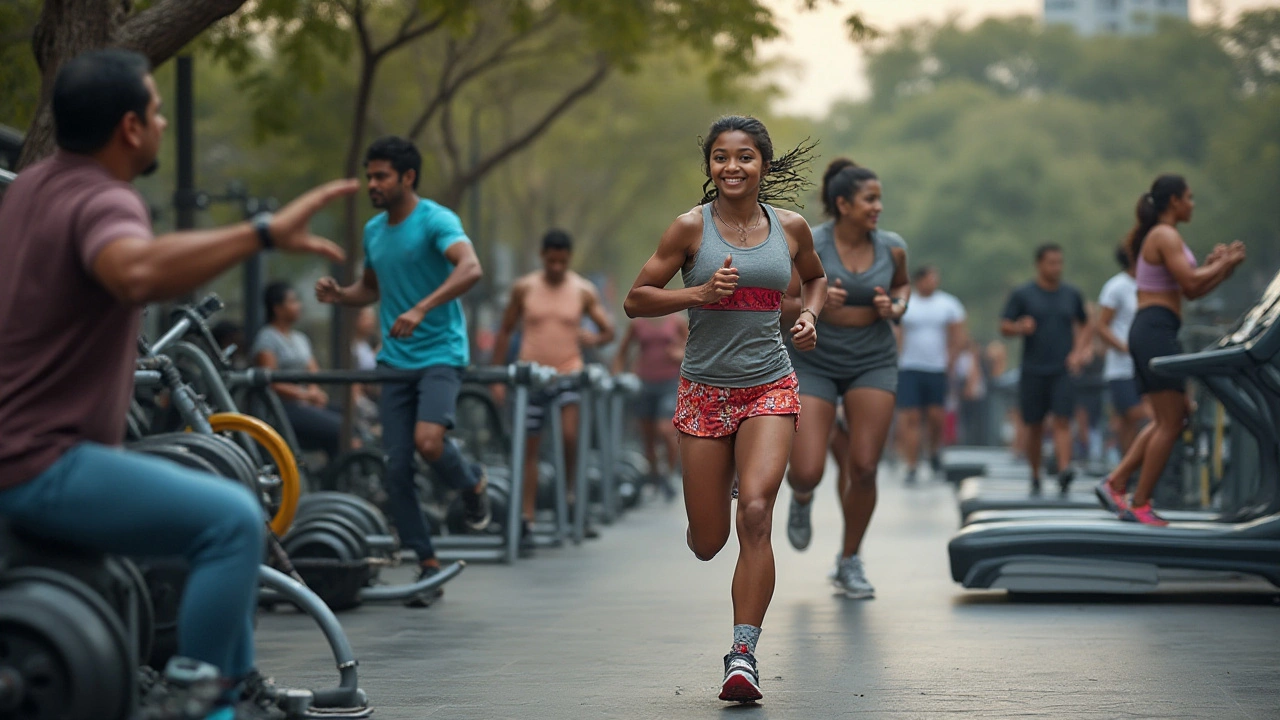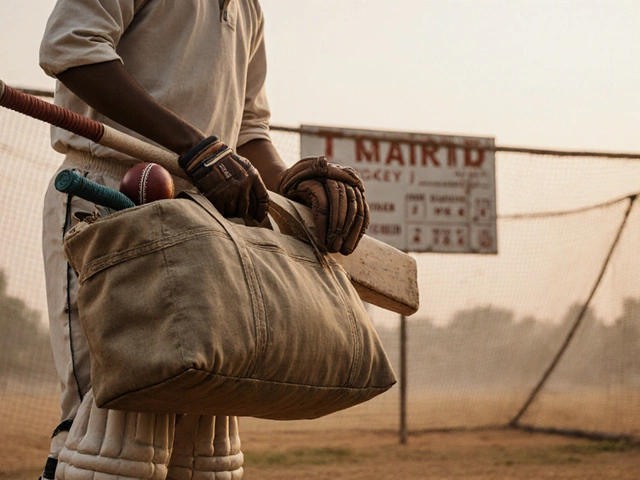In the realm of physical fitness and sports, the attire one chooses can significantly impact performance and comfort. Sportswear has come a long way, evolving with technology and fashion trends to better serve athletes across the globe.
From specialized materials that enhance breathability and flexibility to innovative designs tailored for specific activities, sportswear is more than just clothing—it's a tool that helps athletes push boundaries.
Whether you are a seasoned runner, a casual gym-goer, or someone who enjoys the occasional yoga session, understanding the various aspects of sportswear will guide you in making informed decisions for your athletic wardrobe. Join this insightful journey as we explore the world of sportswear, unraveling its complexities and highlighting what's best for your active lifestyle.
- The Evolution of Sportswear
- Key Features of Modern Sportswear
- Popular Types of Sportswear
- Importance of Choosing the Right Sportswear
- Future Trends in Sportswear
The Evolution of Sportswear
The history of sportswear is a fascinating tale that intertwines advances in technology, changes in social norms, and shifts in fashion trends. Initially, athletic apparel was about utility; it was basic and made from materials readily available. Athletes of ancient civilizations such as the Greeks often participated in sporting events in minimal clothing. It wasn't until the late 19th and early 20th centuries, with the rise of organized sports, that specific attire became more of a focal point. During this era, the introduction of heavy cotton and woolen outfits marked the advent of what we now consider sportswear. These materials, however, were far from ideal as they absorbed sweat and were quite uncomfortable. Yet, they laid the groundwork for what's to come.
The mid-20th century marked a significant shift. As athletics turned more competitive, there was an actual drive to improve the function of sports apparel. Synthetic materials like nylon and polyester, developed out of wartime innovations, began infiltrating the sports domain. These fabrics were lighter and offered a degree of flexibility and moisture resistance that was previously unattainable. The 1970s fitness boom saw a rise in individuals striving for healthier lifestyles, creating an unprecedented demand for functional yet fashionable sportswear. This era brought about stylish gym gear and ushered in a wave of fitness icons who popularized various trends.
The latter part of the century and into the new millennium saw incredible advancements. The introduction of performance fabrics like Lycra revolutionized sporting apparel by providing unprecedented comfort and stretch. Technology's role became prominent, too, as manufacturers began developing smart textiles that could monitor body temperature or heart rates. Brands started incorporating athletic apparel as part of their product lines, and soon, it wasn't just athletes wearing this emerging category of clothing – it seeped into street fashion, becoming an extension of one’s lifestyle and identity. As fashion and functionality blended, the era of athleisure was born.
Today, fitness clothing comes with added focus on sustainability. Brands are experimenting with recycled and eco-friendly materials, recognizing the important role they play in the environment. With continuous technological advances, the expectation is that sportswear will become even more personalized, with garments potentially able to provide haptic feedback or enhance recovery times.
"Innovation in sportswear is about breaking boundaries – it’s about making the impossible possible," remarked legendary athletic gear designer, Aimee Mullins, emphasizing the industry’s forward-thinking approach.The exciting journey of sportswear over centuries has not only transformed athletes’ performances but also reflects broader societal trends, and it shows no signs of stopping here.
Key Features of Modern Sportswear
Modern sportswear stands as a fusion of technology and fashion, crafted to enhance athletic performance while maintaining a sense of style. At the core of *sportswear* design is the fabric choice, which has seen immense innovation in recent years. Key among these advances is the use of moisture-wicking materials, which draw sweat away from the body. This promotes evaporation, keeping the skin dry and comfortable, a crucial feature for athletes pushing their limits. Synthetic fibers such as polyester and nylon are often blended with natural options like cotton to strike a balance between breathability and moisture control. This combination ensures durability and flexibility, essential qualities for rigorous activities.
Sportswear also embraces ergonomic designs, prioritizing the natural movement of the human body. This is evident in features like strategic stitching and seamless construction, which minimize friction and reduce the risk of chafing. For athletes who require an extensive range of motion, such as yogis and runners, the inclusion of stretchy, form-fitting materials enables unrestricted mobility. This blend of comfort with efficiency underscores the evolution from traditional loose-fitting attire to sleek, body-hugging designs.
In addition to comfort and functionality, the aesthetic appeal plays a significant role in *athletic apparel*. With the boom of the athleisure trend, which blurs the lines between sportswear and casual wear, designers focus on style as much as substance. Colorful patterns, unique textures, and fashionable cuts allow wearers to express individuality while maintaining a look that's both practical and on-trend. John Smith, a renowned designer, once noted,
"The future of sportswear lies in garments that are as much a part of your everyday life as your athletic routine."This statement encapsulates the growing importance of versatility in *fitness clothing*.
Moreover, advancements in technology have seen the incorporation of smart textiles in sports equipment. These fabrics can monitor heart rates, regulate body temperature, and even provide feedback on posture and movement. Such innovations are paving the way for a more connected workout experience, offering athletes real-time data to enhance training efficiency. For instance, tops embedded with LED lights increase visibility for nighttime runners, marrying safety with functionality in smart ways.
Finally, sustainability has become an integral aspect of modern *sportswear* development. With growing environmental awareness, many brands are shifting towards eco-friendly materials and production processes. Recycled fibers and organic fabrics are gaining popularity, aligning with consumer demand for ethical fashion choices. This shift not only reduces the carbon footprint of athletic apparel but also sets a precedent for the industry to follow. As we look to the future, the emphasis on sustainability will likely continue to shape the innovation of activewear, ensuring that high-performance does not come at the planet's expense.

Popular Types of Sportswear
When it comes to engaging in a sport or a demanding fitness regimen, not all clothing is created equal. What you wear can greatly influence your comfort level, the effectiveness of your training, and even your enthusiasm for exercise. There are numerous categories in the world of athletic apparel, each crafted to cater to specific activities and sporting needs, ensuring optimal performance and a comfortable experience. Walking into any sports store, the varieties might seem overwhelming, but knowing what options are available can help simplify this choice. Clothing designed specifically for running, for instance, often features lightweight, moisture-wicking fabrics that prevent chafing and quickly evaporate sweat, keeping the athlete cool and dry even during long distances. In contrast, sportswear for cycling includes padded shorts to enhance comfort on the saddle and aerodynamic tops to reduce wind resistance.
Gym enthusiasts generally favor breathable and stretchable materials such as those used in the making of fitness tights, tank tops, and cozy, yet functional, hoodies. These cater to both flexibility and style, encouraging dynamic movements and a modern, sporty look. As for yoga practitioners, the trending yoga pants and snug tops often incorporate elements of style and practicality. These are crafted to offer unrestricted movements, cater to deep stretches, and maintain a snug fit that doesn’t ride up or slide down during inverted positions.
According to expert sportswear designer Stella McCartney, "The best sportswear balances form and function, melding technology with design to push boundaries while providing something that athletes feel confident wearing."Football or basketball clothing tends to be loose-fitting to ensure complete freedom in movement while still incorporating technology to manage sweat. These include breathable mesh jerseys and supportive, padded shorts that promise both reliability and safety. If you’re someone who enjoys football or basketball, investing in a good quality pair of compression shorts or a durable jersey can indeed make a significant difference.
Athletes participating in outdoor sports often have different needs. Rock climbers, hikers, and skiers require durable and weather-adaptive outfits, typically including base layers for warmth, water-resistant outer layers, and supportive mid-layers for comfort. These collections often exhibit advanced textile engineering to withstand arduous climates while ensuring breathability and aerodynamics. The realm of specialized sportswear even boasts smart garments equipped with sensors to track biometric data providing real-time analytics and performance tips, a field that is enticing more tech-savvy athletes.
Indeed, fitness clothing is not purely about practical functions; it’s about defining a growing lifestyle choice centered on health and activity. Understanding the diverse types allows fitness enthusiasts to align their purchases with their goals, style, and comfort needs. Ensuring you have the right sportswear not only enhances performance but also encourages a more dynamic and fulfilling sporting experience.
Importance of Choosing the Right Sportswear
Choosing the right sportswear is more than just a matter of fashion; it's a crucial factor that can significantly affect your performance and overall experience in sports or exercise. When you wear the right sportswear, you're ensuring that your body can move efficiently, reducing the risk of injury and enhancing overall comfort. For instance, runners often choose clothing with moisture-wicking properties to keep sweat away from their skin, thereby reducing chafing and irritation. The right clothing can regulate body temperature more effectively, which is particularly important for outdoor activities, where weather conditions can fluctuate rapidly.
Another key consideration when selecting athletic apparel is the range of motion it allows. Sportswear should provide the proper stretch and flexibility to accommodate dynamic movements without restriction. This holds substantial value in activities like yoga, where unrestricted motion can lead to a more fulfilling practice. Likewise, in sports such as basketball or soccer, unrestricted clothing allows for jumping, running, and quick directional changes. Even activities that seem more stationary, like weightlifting, require the right sportswear to ensure that joints and muscles are supported, lessening the chance of mishaps.
Comfort is not merely a physical sensation; it ties into mental performance as well. When athletes are free from distractions caused by ill-fitting or inappropriate clothing, they can concentrate better on their technique and strategy. The University of Cologne conducted a study showing that athletes who wore specially designed sportswear reported higher focus levels. This effect translates into measurable performance improvements, such as faster lap times or higher jumps. It's said that Olympic swimmer Michael Phelps, for instance, always paid meticulous attention to his choice of swimsuit material and fit, as the wrong suit could mean the difference between gold and silver.
"Sweat-wicking fabric is a game-changer," says physiologist Dr. Jessica Matthews, "because it not only keeps athletes dry but also significantly impacts their thermal comfort and endurance."
Making an informed decision about your fitness clothing embodies not just the technical aspects like fabric and design, but also personal style and individual needs. Brands now offer a plethora of styles with various functional features tailored to specific sports or fitness regimes. This diversity ensures that everyone can find sportswear that not only fits well but makes them feel confident and ready to perform at their best. As each athlete is unique, the choice of sportswear should align with personal preferences while still focusing on functionality, style, and resilience.
In summary, the importance of selecting the right sportswear lies not just in enhancing physical performance but in contributing to psychological preparation. When you step onto a tennis court or hit the hiking trail wearing clothes that make you feel ready and fit for the task, it does wonders for your self-esteem and motivation. The right choice in sportswear not only bridges the functional gaps in athletic apparel but also adds an empowering layer to your exercise experience, pushing you towards achieving new milestones.

Future Trends in Sportswear
As we step into an era where technology and fashion continuously blur the lines, the future of sportswear looks nothing short of revolutionary. Trends forecast a surge in smart clothing, integrating wearable technology that goes beyond simple fitness trackers. Imagine apparel equipped with sensors to monitor vital signs, track performance in real-time, and provide instant feedback to improve athlete efficiency. This evolving landscape points towards a future where sportswear not only enhances performance but becomes an integral part of one's health regimen.
The demand for sustainable and eco-friendly materials is another trend set to redefine athletic apparel. As global awareness around environmental issues grows, consumers are increasingly choosing brands committed to reducing environmental footprints. Innovations in fabric technology, such as recycled polyester and organic cotton, are paving the way for high-performance gear that doesn't compromise on environmental values. Companies are exploring waste-minimizing production techniques, ensuring we can enjoy high-quality sportswear while caring for our planet.
According to Euromonitor International, "Sustainable fashion is not just a trend but a necessity if we are to continue resource-dependent industries like apparel in the long run."
Customization of sports equipment is also becoming more accessible. With advancements in 3D printing, personalized sportswear tailored to exact body specifications can optimize comfort and performance. This trend allows athletes to express their personal style, ensuring that their gear is as unique as their talents. Clever design innovations allow for variations in size, shape, and colorways, pushing the boundaries of conventional sportswear traditionally available.
Moreover, the concept of athleisure is expected to expand further, blurring the distinction between workout apparel and everyday wear. People are looking for versatile clothing that seamlessly transitions from the gym to social settings, prioritizing comfort alongside style. This shift not only affirms the importance of fitness clothing in daily life but also highlights the growing influence of sports-inspired aesthetics in mainstream fashion. Brands are rapidly adopting innovative designs that keep up with this trend, creating clothing pieces that appeal to both athletes and non-athletes alike.
A look at the cultural landscape suggests that inclusivity and body positivity are shaping the future of sportswear too. The industry is moving towards designing apparel for a diverse range of body types and preferences, ensuring every individual feels represented and comfortable in their athletic pursuits. This shift is crucial as it champions the idea that fitness belongs to everyone, thus reinforcing the belief that sportswear should accommodate every body, not just the conventionally athletic.
All these emergent trends collectively unveil a promising future for sportswear, making athlete engagement more personalized, sustainable, and inclusive. As brands continue to innovate and adapt to evolving consumer values, we are likely to witness an era where athletic wear plays a pivotal role in shaping lifestyles and pushing the boundaries of human performance.





